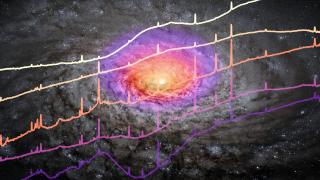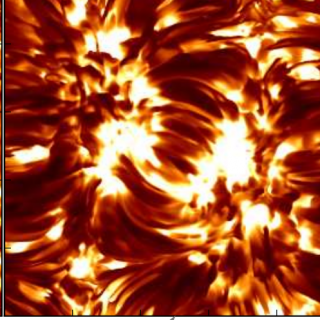Bibcode
Martínez-Paredes, M.; Aretxaga, I.; Alonso-Herrero, A.; González-Martín, O.; Lopéz-Rodríguez, E.; Ramos-Almeida, C.; Asensio-Ramos, A.; Diaz Santos, T.; Elitzur, M.; Esquej, P.; Hernán-Caballero, A.; Ichikawa, K.; Nikutta, R.; Packham, C.; Pereira-Santaella, M.; Telesco, C.
Referencia bibliográfica
Monthly Notices of the Royal Astronomical Society, Volume 468, Issue 1, p.2-46
Fecha de publicación:
6
2017
Número de citas
31
Número de citas referidas
28
Descripción
We present mid-infrared (MIR; 7.5-13.5 μm) imaging and spectroscopy
observations obtained with the CanariCam (CC) instrument on the 10.4-m
Gran Telescopio CANARIAS for a sample of 20 nearby, MIR bright and X-ray
luminous quasi-stellar objects (QSOs). We find that for the majority of
QSOs the MIR emission is unresolved at angular scales ∼0.3 arcsec,
corresponding to physical scales ≲600 pc. We find that the
higher-spatial resolution CC spectra have similar shapes to those
obtained with Spitzer/IRS, and hence we can assume that the spectra are
not heavily contaminated by extended emission in the host galaxy. We
thus take advantage of the higher signal-to-noise ratio Spitzer/IRS
spectra, as a fair representation of the nuclear emission, to decompose
it into a combination of active galactic nuclei (AGN), polycyclic
aromatic hydrocarbon (PAH) and stellar components. In most cases, the
AGN is the dominant component, with a median contribution of 85 per cent
of the continuum light at MIR (5-15 μm) within the IRS slit. This IR
AGN emission is well reproduced by clumpy torus models. We find evidence
for significant differences in the parameters that describe the dusty
tori of QSOs when compared with the same parameters of Seyfert 1 and 2
nuclei. In particular, we find a lower number of clouds (N0
≲ 12), steeper radial distribution of clouds (q ∼ 1.5-3.0) and
clouds that are less optically thick (τV ≲ 100) than
in Seyfert 1, which could be attributed to dusty structures that have
been partially evaporated and piled up by the higher radiation field in
QSOs. We find that the combination of the angular width
σtorus, viewing angle i, and number of clouds along the
equatorial line, N0, produces large escape probabilities
(Pesc > 2 per cent) and low geometrical covering factors
(f2 ≲ 0.6), as expected for AGN with broad lines in
their optical spectra.
Proyectos relacionados

Actividad Nuclear en Galaxias: una Perspectiva 3D del Núcleo y su Entorno
Nuestro proyecto puede dividirse en dos líneas principales de investigación. En primer lugar, el estudio de los vientos producidos por cuásares luminosos oscurecidos y del impacto que estos tienen en sus galaxias anfitrionas (retroalimentación del AGN). Para ello hemos obtenido observaciones en el óptico e infrarrojo cercano con el Gran Telescopio
Cristina
Ramos Almeida

Magnestismo Solar y Estelar
Los campos magnéticos son uno de los ingredientes fundamentales en la formación de estrellas y su evolución. En el nacimiento de una estrella, los campos magnéticos llegan a frenar su rotación durante el colapso de la nube molecular, y en el fin de la vida de una estrella, el magnetismo puede ser clave en la forma en la que se pierden las capas
Tobías
Felipe García

Magnetismo, Polarización y Transferencia Radiativa en Astrofísica
Los campos magnéticos están presentes en todos los plasmas astrofísicos y controlan la mayor parte de la variabilidad que se observa en el Universo a escalas temporales intermedias. Se encuentran en estrellas, a lo largo de todo el diagrama de Hertzsprung-Russell, en galaxias, e incluso quizás en el medio intergaláctico. La polarización de la luz
Ernest
Alsina Ballester